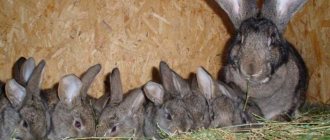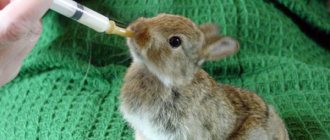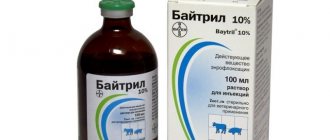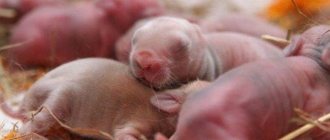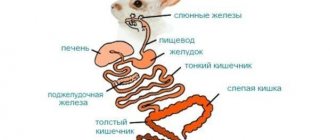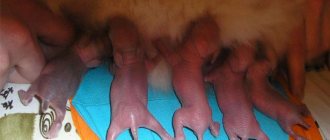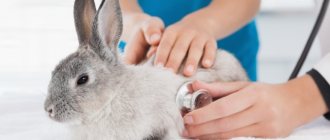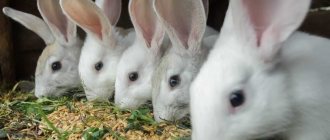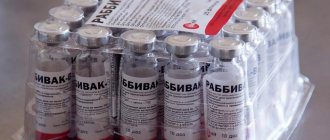Many novice rabbit breeders wonder why rabbits die. The body of these animals is very sensitive to various infections and viruses. Therefore, it is important to know the main diseases of rabbits, to be able to distinguish their first signs, and also to carry out quality prevention in a timely manner.
How to distinguish a healthy rabbit from a sick one?
In order to prevent mass death of the entire farm, it is necessary to regularly inspect each individual and monitor its behavior.
The problem of mortality in the rabbitry remains relevant always
The frequency of inspections is increasing:
- before mating;
- after and before birth.
After the baby rabbits are born, inspect the litter daily. It is the behavior and appearance of the animal that will allow you to understand that the pet is sick.
If the rabbit is doing well, he will have:
- wool to shine;
- calm and measured breathing;
- normal condition of the eyes and nose (no discharge);
- body temperature is not less than 38.5 and not more than 39.5 degrees;
- stable pulse (120-160 contractions in 60 seconds);
- dark brown or black pea-sized feces;
- dark urine.
After the rabbits are born, inspect the brood daily.
If the animal is sick, then:
- Urine may take on other shades (red, orange).
- Unformed feces of a different color appear. Another option is their excessive hardness and dryness.
- The behavior of the individual changes. The rabbit becomes aggressive or, on the contrary, lethargic.
- It becomes difficult for him to breathe. Breathing is noticeable, it is intermittent or rapid.
- Thirst appears.
- Hair falls out. She becomes faded and disheveled.
- Mucous or purulent discharge appears from the eyes or nose.
- There are convulsions.
- The body may tremble.
- Various types of neoplasms, crusts, etc. are observed on the skin.
If such symptoms are present, it is recommended to contact a veterinarian and begin treatment.
A livestock farmer's worst nightmare - distemper
Only 5% of rabbits survive if myxomatosis is registered on the farm, or, as it is popularly called, distemper.
The disease is caused by a virus that spreads through the air and through blood-sucking insects. At first, it does not manifest itself in any way, which is why the disease often comes as a surprise even to an understanding livestock breeder. The absence of symptoms, however, does not prevent a sick individual from infecting its fellows, and distemper quickly covers the livestock.
In animals infected with myxomatosis, the following signs of the disease are observed: pus in the eyes, the appearance of growths on the body, nasal discharge, and apathy. Most often, a sick rabbit dies after 7-8 days. The strongest ones can last 2 weeks.
Treatment of myxomatosis is possible only at an early stage, and even then it is not always effective. The best measure to combat distemper is to vaccinate pets.
How to tell if a rabbit is dying
If your rabbit has seizures, paralysis, or lies down and won't get up, it will most likely die.
Only a veterinarian can say for sure about this after examining the individual.
If your rabbit has seizures, paralysis, or lies down and won't get up, it will most likely die.
To prevent the entire livestock from dying, it is worth isolating all infected animals and moving them to a separate cage. Isolation does not simply mean placing your rabbit in another cage nearby. It should be in a different room altogether.
Why do rabbits die?
The mass death of all or the sudden death of one rabbit - every rabbit breeder faces this sooner or later. The main reasons are lack of proper care, unsanitary conditions, poor quality feed and dirty water. Keeping long-eared rodents in this manner increases the risk of contracting infectious diseases, as well as diseases that are not transmitted from individual to individual.
To prevent mortality or at least reduce the number of affected animals, you need to know the rules and conditions for keeping rabbits, what diseases they are susceptible to and their symptoms, as well as what preventive actions will protect the livestock from death.
Causes of death of little rabbits
Only born rabbits feed on colostrum, then mother's milk. Thanks to him, they develop immunity.
A common cause of death for small rabbits is infection with staphylococcus. This is possible if hygiene standards are not observed when kept in a cage.
Be sure to read:
Why does a mother rabbit eat her babies, how to deal with aggression in rabbits
Other reasons why young animals die:
- Hypothermia. If the female rabbit has poorly prepared the place for the young rabbits, that is, she has collected insufficient amount of fluff, then the offspring will freeze to death. This also happens where the rabbit breeder did not bother about heating in the winter.
- A large amount of fluff, heat in the rabbitry, lack of ventilation. Such conditions are not the best for baby rabbits.
- Malnutrition. If a rabbit is sick with something and has no appetite, then she will have little milk. In this case, the offspring will die of starvation.
- Toxins in milk. This is a consequence of feeding the uterus with poor quality food.
- The presence of any disease in the uterus (mastitis, coccidiosis, etc.).
Any of these manifestations can be prevented by carefully monitoring the animals.
Why do baby rabbits die?
Rabbits die from a variety of diseases, since their immunity is still very weak and cannot fully resist most ailments.
Staphylococcus
The reason for the development of staphylococcus in rabbits is the lack of timely cleaning of the cage. The disease is divided into several types:
- Septicopyemia. It affects young rabbits in the first days of life. Symptoms are ulcers on the body. Death occurs a few days after infection.
- Wandering pyaemia. This form is characterized by the formation of abscesses under the skin or on the internal organs of the animal. In some cases, such an abscess can occur on the inside of the eyeball, which can cause it to bulge.
- General septicemia. With this type of bacteria, the entire body of the rabbits is affected, ulcers appear in any organ, and in case of damage to the peritoneum, death is inevitable. Symptoms include heavy breathing, weakness and elevated body temperature.
Low temperatures
Low temperature in a rabbitry in the presence of newborns leads to the death of young animals due to hypothermia, since the body of the rabbits is not able to regulate body temperature. Therefore, young animals can easily freeze to death. Therefore, to prevent such a problem, you should take care of the normal temperature in the cells. During the cold season, it is necessary to equip the rabbitry with heating systems. You also need to ensure that there are no drafts in the room.
Poor nutrition
For the proper development of baby rabbits, care should be taken to provide a balanced diet to the lactating female, since impaired lactation in a rabbit or the lack of all necessary substances in the milk leads to the death of the offspring.
There are cases when the female refuses to feed the rabbits, then you need to hold the female until the newborns are satisfied with milk. Such procedures are carried out until the female rabbit recognizes her offspring and begins to feed them herself.
Stomatitis
The first sign of this disease is teeth grinding. With the development of stomatitis, drooling and swelling of the oral cavity are added. The danger of the disease lies in the inability of the rabbits to eat properly due to pain.
The disease affects young animals aged from 3 weeks to 3 months. To prevent stomatitis, you should regularly clean the cages and examine the oral cavity of your rabbits.
See also Solikoks for rabbits: instructions for use
Infectious diseases
Baby rabbits suffer from the same infectious diseases as adults. The problem is that the mortality rate in young animals is much higher and is almost equal to 100% if the disease occurs.
To prevent infection, vaccination should be carried out in a timely manner and newborn rabbits should be kept separately from adults. This approach will help reduce the likelihood of young animals becoming infected with infectious diseases.
What to do if pestilence of young animals begins
To prevent epidemics, you need to vaccinate all rabbits.
If young rabbits begin to die, you should:
- Remove all sick individuals to another cage and another room.
- Find out the cause of the disease. A veterinarian will help you do this. He needs to provide the deceased animal for autopsy and diagnosis.
- If the disease is curable, then begin therapy. If not, then eliminate all infected rabbits.
- Those individuals that appear healthy should be quarantined. Exercise special control over them.
- All cages containing sick animals must be disinfected.
If the reason is trivial (hypothermia or overheating), then all conditions for the satisfactory existence of animals must be immediately created.
Important! To prevent epidemics, all rabbits need to be vaccinated. This is done annually.
If pasteurellosis or coccidiosis is diagnosed, these pathologies can be cured with medications.
The best panacea will be proper and balanced food and compliance with sanitary and hygienic standards in the rabbitry.
Non-communicable diseases: flatulence, tympany
Yes, animals suffer greatly from such a seemingly trivial disorder as bloating. Flatulence and tympany are things that rabbits die from not so rarely.
The fact is that these animals have an extremely sensitive digestive system. The slightest failure and a lot of problems arise, which are sometimes irreversible. Flatulence usually occurs when suddenly switching to unfamiliar food or when eating wet food, very juicy greens.
A rabbit suffering from flatulence experiences pain and discomfort, stops eating, falls into apathy, and loses weight. Due to fermentation, harmful microflora grows in the intestines, which begins to destroy its walls. The result is death.
We will tell you what to do if such signs are discovered. The rabbit is left without food for 12 hours, fed with lactic acid and ichthyol solution (10%). However, if the tympany is very strong, it is easier to slaughter the animal.
The most common diseases of adults and young animals
Diseases that most often attack rabbits:
- VHBD - viral hemorrhagic disease of rabbits;
- pasteurellosis;
- coccidiosis;
- myxomatosis.
VHBK (fever) is a viral hemorrhagic disease of rabbits
The high mortality rate of rabbits has been established specifically from VGBV - 95%.
Individuals aged two or more months are affected. Infection occurs through the air, through animal feces, wool and meat.
The high mortality rate of rabbits has been established specifically from VGBV - 95%
The disease may be asymptomatic.
If there is an acute phase, then the sick rabbit will experience:
- anxiety;
- loss of appetite;
- weight loss;
- impotence;
- inactivity;
- the occurrence of seizures;
- throwing the head back;
- blood from the nose;
- squeaking due to constant pain.
The virus kills the animal in a short period (1-3 days). The liver is being destroyed, the lungs are swelling. The disease cannot be treated.
You can only vaccinate for prevention. Initially, the vaccine is given at 1.5 months. This is done again for an adult rabbit at any time, at least twice in 12 months.
Myxomatosis (distemper)
If a rabbit breeder notices mucus from the eyes or nose of his pet, as well as new growths on the body in the form of bumps, this indicates infection with myxomatosis, or distemper.
The incubation period is from one to two weeks. Throughout this time, there are no symptoms, but the animal is already spreading the infection and infecting others.
Be sure to read:
Rabbits' bellies swell and death occurs, how to treat correctly, what to do
Also, during the illness, swelling of the eyes, nodules near the nose and near the ears are observed.
Once symptoms occur, the end is near. Rabbits die within a week, adults within two weeks. The spread of the disease is lightning fast. If you find one sick individual, then 95% of 100% that the entire brood is already infected.
You can fight plague with antibiotic therapy and immunostimulants. Recovery occurs in 40-50% of cases. Prevention of myxomatosis - vaccination.
Important! The meat of a rabbit that has died from distemper is not suitable for food.
Pasteurellosis
The meat of a rabbit that died of distemper is not suitable for food.
The disease kills the body in two days.
Visible symptoms include:
- nasal discharge;
- loss of appetite;
- sneezing.
The better the maintenance of rabbits and their nutrition, the lower the mortality rate from this disease. Both a quarter of the brood and most of it die.
Pasteurellosis is acute and can be chronic.
The acute phase is characterized by:
- elevated temperature (39-41 degrees);
- shortness of breath;
- runny nose;
- the appearance of sneezing.
If the form is acute, the rabbit can die in a matter of days, sometimes even hours.
Symptoms in the chronic form:
- conjunctivitis;
- rhinitis;
- loose stools;
- subcutaneous abscesses (rare).
It is not difficult to cure this pathology. Early treatment does not last long.
The main thing is to normalize the diet so that the animal receives all the necessary vitamins.
For 3-4 days, in the morning and evening, they inject the antibiotic biomycin, tetracycline, and sulfonamide. The vet picks him up.
If the disease has become chronic, the duration of treatment is extended to two weeks. The infected are protected from others. For preventive purposes, the medicine is administered to the entire livestock.
Coccidiosis
Rabbits that have good immune defense do not suffer from coccidiosis.
A disease that affects the liver and intestines. Each individual is a carrier of coccidiosis, but clinical manifestations are observed in only a few.
Symptoms of the disease:
- bloating;
- refusal of food;
- weight loss
Routes of transmission are through water and food. Animals with good immune defenses do not suffer from coccidiosis.
When opening a sick rabbit, they find:
- greatly enlarged liver;
- nodules on the intestines and liver.
Treated with antibiotic therapy. The drugs used are chemical coccide, trichopolum, and sulfadimezin.
What can cause illness
Diseases can be infectious or non-infectious. However, the risk factors that provoke any type of illness are always the same. A newborn rabbit is insured against contagious diseases, the rest are vulnerable.
Most often, rabbits are diagnosed with:
- myxomatosis (distemper);
- coccidiosis (eimeriosis);
- flatulence;
- cysticercosis;
- pasteurellosis;
- tularemia;
- viral hemorrhagic disease.
If a farmer does not understand why rabbits are dying, first of all, you need to think about the living conditions of the animals.
If the cages are not cleaned regularly or improperly, the water in the drinking bowls is not changed, the equipment is not washed, poor food is used and the rabbits are kept in close quarters, the probability of mass diseases and mortality is close to 100%.
Although, caring owners are not immune. Some viruses, bacteria and parasites reach animals through insects. Often, mass death of rabbits occurs after the introduction of new individuals into the farm, which have not been thoroughly checked for the presence of diseases.
The time of year also matters. Many ailments occur more often in summer than in winter, since most microorganisms prefer warmth.
Treatment and prevention of diseases at home
Curing VGBK and myxomatosis still remains a problem. If even one individual in a rabbitry gets sick, almost all the animals will die out as a result.
The only means that can protect livestock is vaccination. It is done annually two to four times a year.
The only means that can protect livestock is vaccination
Coccidiosis and pasteurellosis also sometimes lead to mortality, but if you contact your veterinarian in time, this can be avoided. Pathologies are treated with antibiotics.
Tips for beginner rabbit breeders:
- Always maintain hygienic conditions in the rabbit shed. It should be clean and dry there.
- Excessive crowding of rabbits in a cage has a negative effect. Create space and comfort for everyone.
- Animals need to be fed in a quality and balanced manner. Do not give spoiled food or food that you doubt. If you feed rabbits food that they should not eat, you can poison the animals, which can also lead to death.
- If an individual cannot be cured and it is risky to keep it alive, it should be killed and disposed of.
- Never eat meat from a sick animal.
- Treat cells with a disinfectant solution. Healthy animals cannot be housed without treatment.
Be sure to read:
Myxomatosis prevention and treatment in rabbits, symptoms of the disease, is it possible to eat meat
Tularemia is an invisible disease
Sometimes, in the summer, rabbits suddenly begin to die for no apparent reason. This also happens in winter, but much less often. The usual cause is tularemia.
This disease is caused by a bacterium. It is dangerous not only for rabbits, but also for most other domestic and farm animals, as well as for humans. Transmitted by air, food, and insects.
The disease affects the lymph nodes, which is why there may be no obvious manifestations of the disease. Tularemia is often diagnosed by autopsy. If symptoms occur, the following are: runny nose, high temperature, swollen lymph nodes, loss of appetite, convulsions.
The mortality rate reaches 90%, but some animals manage not to die. They acquire immunity.
Treatment with antibiotics can only help at the very beginning of the disease. There is no vaccine against tularemia for rabbits.
Other reasons due to which livestock die
Livestock mortality is also possible due to:
- flatulence;
- freezing;
- heat stroke;
- bad food;
- lack of vitamins;
- scabies mite;
- mastitis.
For these reasons, one or more rabbits die. Sometimes rabbits die for no reason. This is a sign that the conditions for keeping animals need to be reconsidered.
Bloating (flatulence)
Food is not digested and causes fermentation in the intestines.
This dysfunction is the result of improper introduction of complementary foods or a sudden change in food. Do everything gradually, do not give new food in large quantities.
Symptoms of flatulence:
- refusal to eat;
- weight loss;
- strange behavior of the rabbit (this is a consequence of colic).
Food is not digested and causes fermentation in the intestines. Pathogenic microorganisms develop that have a negative effect on the organ. The result is death.
Heat stroke or freezing
In summer, rabbits can die from extreme heat . If the room where the cages are located is not ventilated, this leads to heat stroke.
The animal begins to breathe heavily and lies down for a large amount of time. If the temperature is not normalized and the room is not ventilated, the rabbits will die.
In winter, when it is frosty and cold, the room must be heated, especially if rabbits are born. If a female rabbit has picked up little fluff, then it is advisable for a rabbit breeder to do this, otherwise the offspring will die out instantly.
Improper feeding, lack of vitamins and other reasons
Due to an inadequate diet, vitamin deficiency may develop. Vitamin deficiency leads to hair loss, inhibition of growth and development of young animals, bleeding in the gums, eye problems, etc. The daily diet should be rich.
If a rabbit has a scabies mite parasitizing its ears for a long time, it eats into the skin and drinks blood. Without treatment, the individual weakens, does not eat and dies.
Another problem is mastitis. Rabbits suffer from it. Small wounds that form after feeding can become infected, which can be fatal.
Non-infectious diseases of rabbits
Why do chickens die
In addition to viral diseases, the life and health of rabbits can also be threatened by non-infectious diseases. As a rule, they do not cause mass mortality, but the death of even one head causes a lot of trouble for the rabbit breeder. The most common ailments:
- Flatulence. It occurs due to an excess of succulent feed, wet grass and the presence of mold in it. The rabbit loses its appetite, the mucous membranes turn blue, and rapid breathing is observed.
- Avitaminosis. Develops with unbalanced food and vitamin deficiency. Observed: hair loss on the back, bleeding gums, dry eyes, growth retardation.
- A rabbit can get heatstroke if the rabbitry is not ventilated and the temperature in it is higher than the required level. The animal becomes lethargic, constantly lies and breathes heavily.
- Trauma. Scratches, abrasions, bruises, and finally, broken limbs - all this is the result of overcrowding of cells, the presence of traumatic equipment in them - feeders or drinking bowls with sharp corners.
- Parasites. Most often, ear mites cause discomfort to the animal. Their presence is indicated by itching and redness of the ears. The rabbit begins to lose hair, loses weight, and develops general weakness and exhaustion
- Mastitis. If the cage where the nursing rabbit is kept is constantly damp and not cleaned, then microbes enter the body through microcracks in the nipples, which can lead to inflammatory processes in the body of varying severity.
These diseases cannot cause instant death, are not epidemic in nature and do not arise suddenly. They appear due to improper feeding and maintenance of rabbits, and the farmer’s lack of the necessary knowledge and experience. If neglected, they will ultimately lead to the death of the animal.
Infectious diseases: coccidiosis, cysticercosis, pasteurellosis
Coccidiosis is caused by parasites that infect the gastrointestinal tract. There are two stages of disease development:
- in the animal's body;
- in the environment.
Up to 70% of animals die from the disease. The disease can be liver and intestinal. Hepatic coccidiosis continues for two months. At this time, the animal is exhausted. The intestinal form disappears in ten days, after which the animal dies. The rabbit is incubated for three days. He has jaundice and his stools contain blood. The age of the animal may vary, but most often two-month-old rabbits are susceptible to this. The disease is diagnosed using laboratory tests.
Coccidiosis is treated in several ways:
- 1. Use of iodine solution at the rate of 0.01% solution per day per 100 g of body weight. For pregnant females, the dosage is increased after the 25th day of pregnancy. Rabbits are treated in the same way with a dosage half as much.
- 2. Treatment with a solution of a sulfonamide drug. The animal is treated twice a day for five days.
Another disease that is widespread in rabbits is cysticercosis. It is caused by cestode larvae. The liver is affected and peritonitis begins. It mainly affects young animals under the age of 1 month.
A sick pet looks lethargic and has no appetite at all. Once the body becomes too weak, the animal dies. When the abdomen is opened, the extent of the damage can be seen. White blisters are found on the patient's liver. Diagnosis is carried out using an allergen that is injected under the skin. There is no cure for cysticercosis in rabbits. The only thing that can be done is to carry out preventive measures in time to prevent the development of the disease. The rabbit corpse is disposed of by burning. As a preventive measure, animals are given a solution of 10% mebendazole granules, which is mixed with food. The course is one month.
Pasteurellosis is a common disease among domestic animals. It affects the entire population if there is at least one animal in the nursery. They suffer from it regardless of age. The source of infection is a sick animal and household items. Birds and rodents can be carriers of the infection.
The first clear sign of pasteurellosis is a sharp increase in temperature to 42 °C. The rabbit's breathing is rapid and his condition is depressed. Signs of the disease disappear after a few days, and the temperature drops to 33 ° C, after which the rabbit dies. The chronic form of the disease may be due to the manifestation of chronic rhinitis.
Pasteurellosis is treatable. Rabbits are given antibiotics such as chloramphenicol or biomycin. Vaccination is also done for prevention. The animal's skin is disinfected and its entrails are disposed of. Meat is allowed to be eaten.
Cysticercosis is the scourge of young animals
This disease is also one of those that occurs secretly for a long time. Often animals simply die and only after an autopsy it is possible to understand the cause.
Cysticercosis is caused by tapeworms. Or rather, their larvae, which hatch from eggs and spread to various organs of the animal. If he has a strong immune system, the larvae remain encapsulated and do no harm, but the meat of such a rabbit is dangerous.
If the animal is weak or has swallowed many eggs at once, the body cannot suppress the parasites. Then symptoms arise: weakness and depression, increasing diarrhea, loss of appetite, yellowness of the skin, mucous membranes, and whites of the eyes. If you press a rabbit's stomach in the liver area, it will show that it is in pain, since the parasite is concentrated in this organ.
Another symptom of cysticercosis is rapid exhaustion. If your rabbit is rapidly losing weight, and you cannot understand why, it may have this disease.
Cysticercosis is treated with anthelmintic drugs: mebendazole, praziquantel and others. In the article “About worms in rabbits” you will find a lot of interesting information.
Non-contagious diseases of rabbits
Now we should talk about those diseases that can only affect a single individual of the livestock. Yes, they are not as dangerous as the infectious and viral diseases described above, but they are also capable of causing considerable damage to the household. When a breeder rabbit or one of the breeding females is affected, this is a reason for the rabbit breeder to worry.
Injuries
Of course, even in household conditions, rabbits are not immune to various injuries, bites or cuts. And the reasons for the occurrence can be very different: a fight with other animals, an improperly equipped cage, or simply an accident. To avoid injury, you need to follow several recommendations. All of them, in one way or another, relate to rabbit hutches in which animals are kept.
Secondly, the design should not be traumatic. Gaps in the floor, protruding pieces of wire or grating, splinters in the boards, and all other defects should be eliminated with all possible care.
Third, it is better to make cages designed for solitary confinement. Enclosures are acceptable, but the animals must be well controlled (which is problematic). And fights between rabbits can lead to broken limbs that cannot be healed.
Problems with thermoregulation
If kept outdoors, the cage should protect the rabbit from direct sunlight. Why? Heatstroke. This reason can easily lead to increased mortality among these animals in the summer. This is the period when a canopy, a closed sleeping area or some kind of curtains are simply necessary.
In addition, in cold weather such protection will be useful for combating drafts. Rabbits are not afraid of frost as such, while sharp gusts of wind can easily lead to a cold. It is not uncommon for litters of small rabbits to die from this “primitive” disease.
Improper feeding
With an incorrectly selected diet, there is a high risk of causing severe harm to the health of rabbits. Bloating, vitamin deficiencies, diarrhea are just a small part of the list of problems that an unhealthy diet can lead to.
The first thing to remember is that rabbits should not be fed fresh grass. Only slightly dried or straw (in winter). The second is compound feed. It can and does lead to necessary weight gain. Third, all food must be clean and changed regularly. If the rabbits have not eaten food within 24 hours, it is better to throw it away and continue to feed it in smaller portions.
An important point. Plants, any of which may be poisonous to rabbits:
- buttercup;
- fighter;
- hellebore;
- Colchicum;
- celandine;
- hemlock;
- tobacco;
- juniper.
And finally - watering the rabbits. They should always have access to clean and fresh water. To do this, anyone can easily make automated drinking bowls that work on the principle of communicating vessels.
Heatstroke
Rabbits are afraid of both too low and too high temperatures. While frost can cause frostbite, heat can cause heat stroke. Therefore, in the warm season, drinking bowls should always be filled with water, and the cages themselves should be ventilated. If rabbits are kept outdoors, they should be protected from direct sunlight.
You can recognize that a rabbit is not feeling well if the pet is breathing heavily, looks tired, and constantly lies on its side. In addition, redness of the mucous membrane and straightened fingers can indicate unwellness due to the heat.
To prevent your pet from having convulsions that will end in death, urgent measures must be taken.
Lack of vitamins
The rabbit's body may be depleted due to a lack of vitamins and nutrients. Vitamin deficiency can also lead to the death of a pet
In order for the animal to receive all the substances necessary for health, you should pay attention to nutrition. To do this, you need to think through the diet in such a way that the rabbit receives maximum benefits every day.
Vitamin deficiency can also be treated with antibiotics, however, in this case it is necessary to know the exact dosage of the drug. In addition, antibiotics, while improving nutrition, do not have the best effect on the intestines.
The most obvious deficiency in vitamins A, D, and E is manifested in rabbits. For young animals, this is dangerous because, in addition to stunting growth, it contributes to the appearance of diseases that can lead to death.
Inflammation, poisoning and mites
If a farmer is not careful, he may unwittingly poison the rabbits. With fresh grass in the feeder there may be harmful plants: horsetail, caustic buttercup, beet or potato tops, urman. Having been poisoned, rabbits begin to stagger, saliva flows from their mouths, diarrhea occurs, and sometimes convulsions. Death occurs due to intoxication. Poisoning is treated with activated carbon, enemas and laxatives.
Scabies mites themselves do not cause death, but they lead to complications due to which the animal dies. Parasites settle in the ears, corrode the skin, which begins to itch very much. The rabbit becomes restless and loses its appetite. Ear mites often cause otitis media.
Rabbits, especially young animals, are susceptible to inflammatory diseases. Drafts, cold and dampness can lead to pneumonia. Gastritis and intestinal inflammation are a consequence of negligent attitude towards pet nutrition. Unsanitary conditions and floors made of mesh lead to pododermatitis – ulcers on the paw pads.
Vitamin deficiencies are also dangerous.
All these diseases, if left untreated, lead to the death of animals.
Prevention measures
To prevent illnesses and problems, do the following:
- They remove waste and leftover food in a timely manner and change the water. A mesh floor helps to collect waste.
- Disinfection is carried out regularly.
- Organize and maintain good ventilation.
- Rabbits are examined: small ones - daily, adults - at least once every half month.
- Vaccinations are given when the juveniles are approximately 45–60 days old. Immunity does not appear immediately. The vaccination is repeated every year. Vaccinations are a reliable and sometimes the only way to protect, for example, with VGBV.
- Make sure that there is no dampness in the rabbitry.
- They fight the cold and heat in the cages.
- Avoid stress or reduce it to a minimum.
- Pay attention to feed. Products must be fresh, with a set of necessary substances, in normal volumes. There should always be enough water, especially for pregnant, lactating, weakened and elderly animals.
- Remove parasites: mice, rats and insects.
- Isolate sick individuals.
- For prevention, even healthy-looking rabbits are treated.
- The carcasses of dead individuals are destroyed, and cages, equipment, and premises are disinfected after them.
- They keep order. Fights and injuries are not allowed.
- Protects from other animals.
- Spacious cages and regular walks are provided.
- They keep the livestock in warm rabbitries and fight against drafts.
- Only suitable animals are allowed to breed. Some diseases are passed on to offspring.
